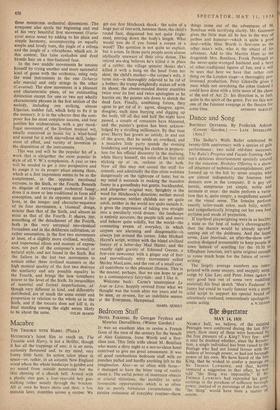Macabre
THE TROUBLE WITH HARRY. (Plaza.) HITCHCOCK'S latest film to reach us, The Trouble with Harry, is not a thriller, though it has all the trappings of one; it is an eerie, curiously flavoured and, to my mind, very funny little farce. Its action takes place in space—or, rather, in an autumn New England wood where the whole landscape is golden and no sound from outside penetrates but the thin chiming of a church bell. Armed with a plastic sten gun, a four-year-old boy goes stalking rather noisily through the bracken All at once he hears shots and then. a few minutes later, stumbles across a corpse. We get our first Hitchcock shock: the soles of a huge pair of feet with, between them, the child's round face, disquieted but not quite fright- ened, peering down the body's length. What would you do if you found a corpse in a wood? The question is not quite so explicit, but it arises. In those parts people seem almost idyllically unaware of their civic duties. The retired sea-dog believes he's killed it in place of a rabbit; the village spinster thinks she's killed it with a bang on the head from her shoe; the child's mother—the corpse's wife, it turns out—is thoroughly relieved to be rid of a bother; the tramp delightedly makes off with its shoes; the absent-minded doctor stumbles twice over its feet and twice apologises as he hurries on; the painter sits down to sketch the dead face. Finally, combining forces, they agree to get rid of it: agree, disagree, agree, disagree, each time burying and digging up the body, till all day and half the night have passed, a couple of romances have bloomed, and the painter's genius has been acknow- ledged by a strolling millionaire. By that time poor .Harry has grown so untidy, in and out of the grave, that he needs an overhaul, and a macabre little party spends the evening laundering and pressing his clothes in prepara- tion for his official discovery in the morning, while Harry himself, the soles of his feet still sticking up at us, reclines in the bath. Now all this may not sound the stuff for comedy, and admittedly the film often wobbles dangerously on the tightrope of taste; but to my mind it succeeds in making the macabre funny in a goosefleshy but gentle, backhanded, and altogether original way. Sprightly is the word for Hitchcock's direction; neither moral nor gruesome, neither childish nor yet quite adult, neither in the world nor quite outside it, it gives the impression of taking you straight into a peculiarly vivid dream: the landscape is entirely accurate, the people talk and move and behave quite solidly, but the world—the connecting events of everyday, in which corpses are alarming and disagreeable—is always just around the corner. John Michael Hayes's script, written with the bland civilised lunacy of a latter-day Mad Hatter, and the exactly right gravity of Edmund Gwenn, a first-rate newcomer with a ginger cap of hair and marvellously witty movements called Shirley MacLaine, and the rest of a small cast, all contribute to this pleasant illusion. This is the nearest, perhaps, that we can hope to get to a contemporary fairy-tale: and I like it.
Welcome back: Carne's masterpiece Le Jour se Lave, happily revived from what we thought was the tomb after ten years and to be seen, or re-seen, for an indefinite season at the Everyman, Hampstead.
ISABEL QUIGLY


































 Previous page
Previous page